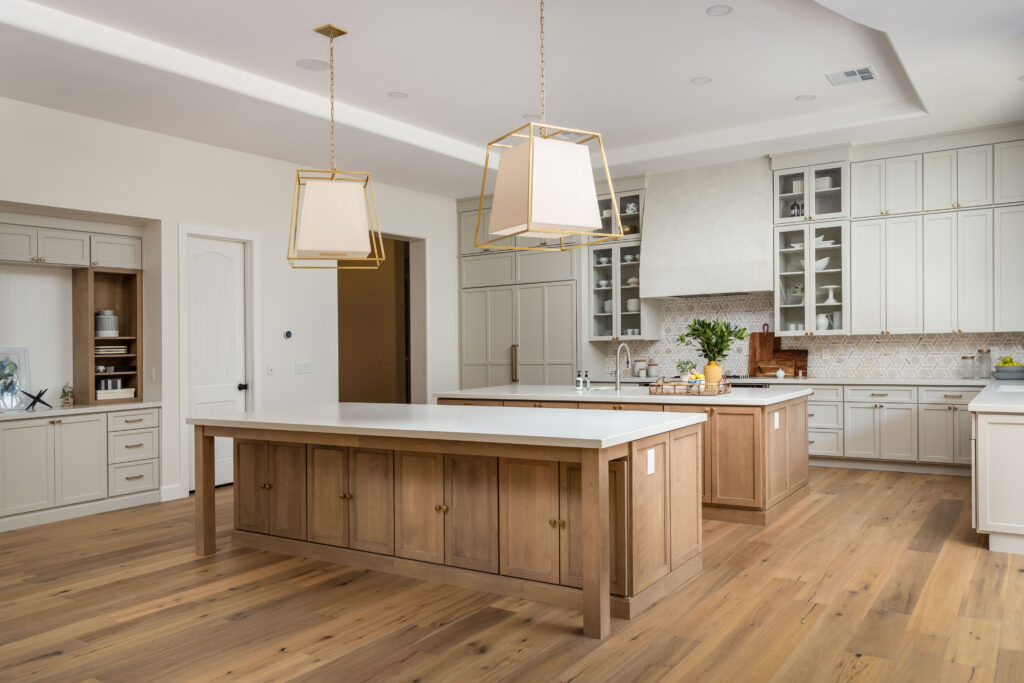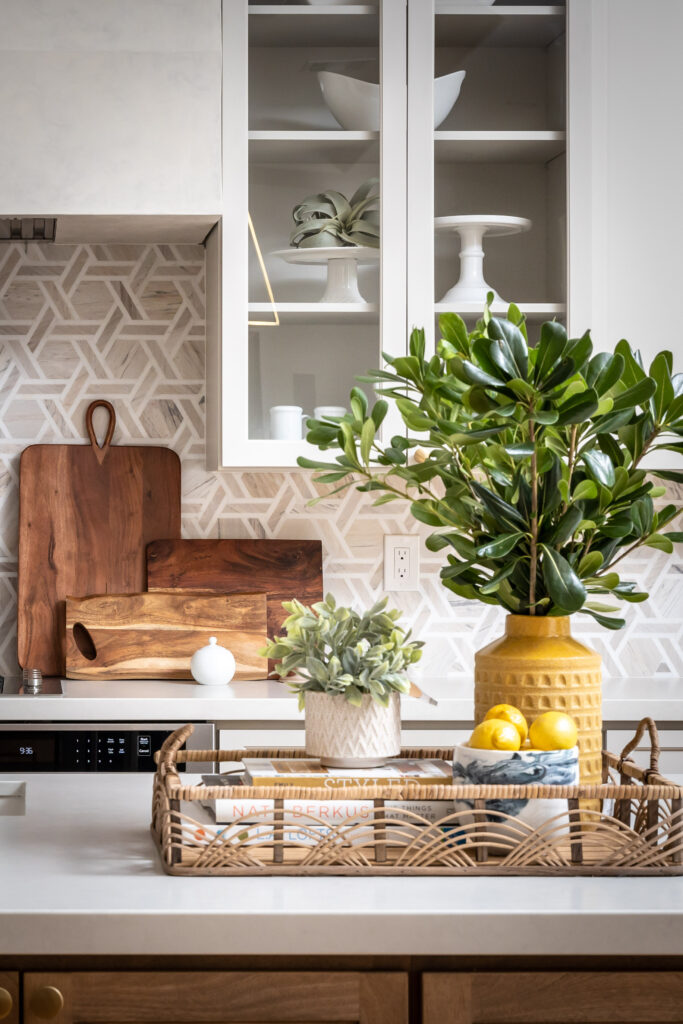
We get it. The thought of a kitchen remodel can seem daunting. You might be envisioning a chaotic construction zone in the heart of your home, disrupting your daily life. But we’re here to dispel that myth.
In reality, a kitchen remodel doesn’t have to be a hassle.
Let’s dive into the process of turning an ordinary space into your dream kitchen.
1. Understanding Your Needs and Goals
Before embarking on any kitchen remodel, it’s vital to assess your needs and set clear goals. Here’s what to consider:
- Budget: Define your budget upfront to ensure your kitchen remodel stays within feasible financial boundaries.
- Pain Points: Identify what isn’t working in your current kitchen design. Is it a lack of storage? Are there any inefficiencies in the layout or flow of the kitchen that make cooking/preparing meals difficult or time-consuming? The current kitchen design that don’t align with your aesthetic preferences or desired style?
- Goals: Determine what you want to achieve with your kitchen remodel. Whether it’s to improve storage, upgrade appliances, or simply enhance aesthetics, having clear objectives will guide your remodeling decisions.
2. Exploring Kitchen Layouts and Design Ideas
The layout of your kitchen can significantly impact its functionality and aesthetic appeal. Here are some popular Phoenix kitchen layout options:
- Open Concept: An open concept kitchen design is characterized by a lack of walls or barriers separating the kitchen from other living spaces, such as the dining area or the living room. This layout promotes a sense of spaciousness and connectivity, making the kitchen feel larger and more inviting. It also facilitates social interaction and easier communication between people in different areas of the home.
- Island Centric: A kitchen island is a freestanding piece of cabinetry or countertop that is positioned centrally within the kitchen space.This layout offers extra countertop space, additional storage, and a social hub for gatherings.
- Galley Layout: A galley layout is perfect for smaller spaces, maximizing efficiency by arranging cabinets, appliances, and work surfaces along two parallel walls.
- U-Shaped Kitchen Layout: In a U-shaped kitchen layout, cabinets, countertops, and appliances are arranged along three walls, forming a U-shape.
3. Selecting Quality Materials and Finishes
Your choice of materials and finishes can dramatically influence the look and feel of your kitchen. For instance, ere are some considerations for your kitchen remodel:

Countertops:
The choice of your countertop material is more than just an aesthetic decision. The materials chosen can dramatically impact the functionality and longevity of your kitchen, for example:
- Quartz countertops, offer a sleek, modern look and are renowned for their durability and non-porous surface, making them resistant to stains and easy to clean.
- Granite, on the other hand, provides a classic, high-end aesthetic with unique patterns in each slab, adding a touch of luxury to your kitchen.
- Butcher block countertops, for instance, while requiring more maintenance, bring a warm, natural element to your space and provide a sturdy, knife-friendly surface for those who love to cook.
Cabinetry:
Your cabinets are not only essential for storage but also significantly contribute to the overall look of your kitchen.
- Hardwood: Hardwood species like oak, maple, cherry, birch, and walnut are popular choices for kitchen cabinetry due to their durability, strength, and natural beauty. They offer a timeless appeal and can be stained or painted to suit various design preferences.
- Softwood: Softwood species such as pine or cedar are occasionally used for cabinetry, particularly in rustic or country-style kitchens. While softwoods may be less expensive, they are also softer and more prone to dents and scratches compared to hardwoods.
- Plywood is constructed from thin layers of wood veneer glued together, creating a strong and stable material for cabinetry construction. It is often used for cabinet boxes, shelves, and drawer bottoms due to its resistance to warping and twisting. Plywood comes in various grades, with higher grades having fewer imperfections and a smoother surface finish. It can be left unfinished, stained, or painted to achieve the desired look.
- Thermofoil cabinets are constructed from MDF or engineered wood, which is then covered with a thin layer of vinyl film using heat and pressure. This creates a seamless and smooth surface that is resistant to moisture, stains, and fading. Thermofoil cabinets come in a variety of colors and styles, offering a cost-effective alternative to painted or stained wood cabinets. However, they may be susceptible to delamination or peeling over time, particularly in high-heat areas.
Each cabinetry material has its own set of advantages and considerations in terms of durability, appearance, cost, and maintenance requirements. By carefully evaluating these factors and considering personal preferences and budget constraints, homeowners can choose the cabinetry material that best suits their needs and enhances the overall design of their kitchen.
Don’t forget the hardware—knobs and pulls can be the finishing touches that tie your kitchen design together.

4. Adding Your Own Dash to It
Vases:
- Introducing vases into your kitchen decor allows for a blend of functionality and aesthetics. From sleek glass designs to rustic ceramic pieces, vases can hold fresh flowers or stand alone as decorative elements. Their strategic placement on countertops or shelving units can add depth and texture to your kitchen.
Greenery:
- Plants can breathe life into your kitchen, creating a vibrant and refreshing atmosphere. Aromatic herbs on your windowsill, a hanging basket with trailing plants, or even a statement indoor tree can transform your kitchen into a lively, inviting space. Besides their visual appeal, plants also improve air quality, enhancing the overall healthiness of your kitchen.
Decorative Accessories:
- Decorative Accessories: Personalize your kitchen with a curated selection of decorative accessories. For instance, a collection of antique cooking utensils displayed on open shelves, a unique piece of wall art that tells a story, or a vibrant rug that adds warmth and color. Even everyday items like a set of handcrafted wooden cutting boards or a retro-style toaster can serve as decorative elements when displayed with intention.
Conclusion:
In conclusion, transforming your ordinary kitchen into your dream kitchen is possible.
- Vital Considerations: Before diving into a remodel, it’s crucial to establish a budget, identify pain points, set clear goals, and explore various layout options.
- Layout Options: Whether you prefer an open concept, island-centric, galley, or U-shaped layout, understanding the pros and cons of each helps in decision-making.
- Material Selection: Choosing durable and aesthetically pleasing countertop materials like quartz or granite, along with quality cabinetry options such as solid wood or MDF, ensures long-lasting satisfaction.
- Personalization: Adding personal touches with decorative accessories, greenery, and lighting transforms the kitchen into a unique and inviting space reflective of individual style and preferences.
Still not sure how to start? Schedule a FREE kitchen remodel consultation here.
Sources:

